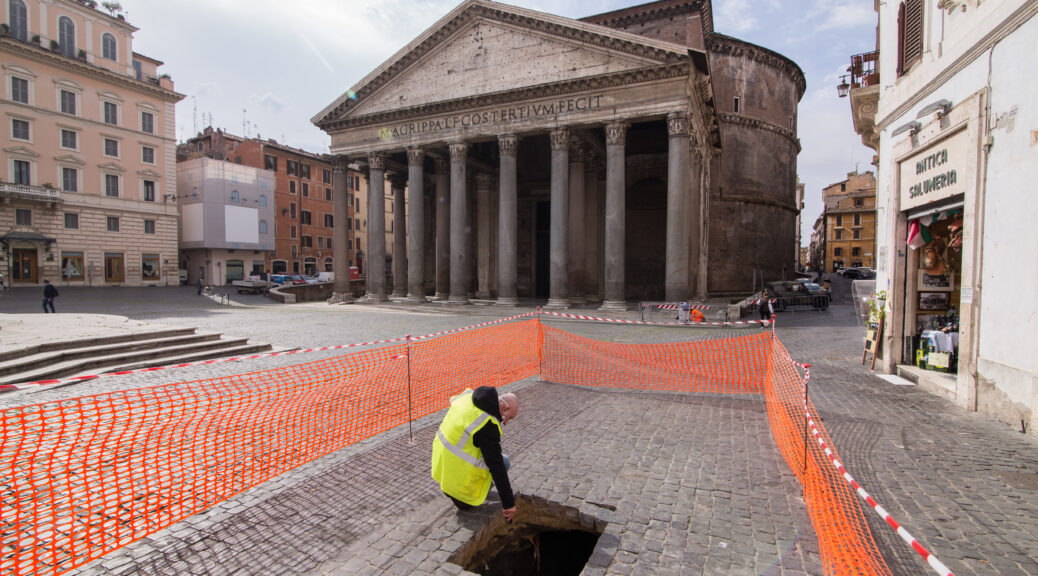Rome Sinkhole Makes Extraordinary Archaeological Find

The Roman Archaeologists have confirmed that the sinkhole that opened up in front of the Pantheon in recent days has brought to light the ancient imperial flooring in Piazza Della Rotonda.
In addition, the discovery of the seven travertine slabs, which are situated at about 2.5 meters below piazza level, is, in fact, a rediscovery.
The flooring was uncovered during works in the 1990s but was sealed up again after being documented by archaeologists who have now had a chance to re-examine the ancient remains.
“More than 20 years after their first discovery” – explains Daniela Porro, special superintendent of Rome – “the slabs of the ancient floor of the square in front of the Pantheon emerge intact, protected by a layer of fine pozzolan”, in what he described as “unequivocal proof of the importance of archaeological protection, particular in a city such as Rome.”
In imperial times the square was much larger than the current one, opening out in front of the Pantheon, the temple dedicated to all the Roman gods, built by Agrippa between 27 and 25 BC.
The area was completely transformed in the second century AD, under Emperor Hadrian, with the level of the piazza raised and repaved.

However, the appearance of another sinkhole in the city is also further evidence of why ancient Romans became master hydrologists specializing in systems of channeling and holding water like tunnels, cisterns, spas, bath-houses, channels, and aqueducts.
Only in January this year, The Local reported that a Rome apartment building has been evacuated and that a street was closed after “a sinkhole opened up” near the Colosseum.
Located on Rome’s famous Via Marco Aurelio, near the ancient Roman gladiatorial landmark, an apartment building, and two businesses were evacuated, and the street temporarily closed, as firefighters, police and housing authorities carried out emergency structural checks.
And The Local reported in February 2018 that a massive ten meters (33 feet) deep sinkhole occurred in the Balduina district, a residential area northwest of Vatican City, into which seven parked cars fell, with 22 families being evacuated from the residential area.


Why on Earth, does this sinkhole phenomena occur so frequently in Rome, and not in say Naples or Milan? After the January 2020 sinkhole, the mayor of Rome, Virginia Raggi, told TG24 News that technicians were at something of a loss trying to explain the geological causes of the incident, and she said sinkholes (known as voragine) are a “major problem in central Rome.”
Traditionally, on average every year 30 fresh sinkholes, subsidence, and other collapses are recorded in Rome, but what is alarming, according to The Local, is that since 2008 the annual figure has “tripled.”
Searching for a cause, a 2018 Guardian article asked should we “blame the rain, the government or just geology,” not only for sinkholes but for increasing extreme weather events in Italy, in general?
The article opens with reference to a shocking statistic published in Roma Republica, that in the first four months of 2018, Rome suffered an astonishing “44 sinkholes,” once every two or three days, with an average of “90 sinkholes a year in Rome since 2010.”
Many blame the rain in Rome, because in 2018 it was the wettest six months in living memory, and this may have had catastrophic effects on Rome’s geology, as the city is founded upon a floodplain, and most of it still rests on a sandy, soft soil.
Water finds no resistance in penetrating this permeable substrate, especially now that its gravitational path of destruction is assisted with the cracks caused by the vibrations of thousands of cars, trucks, and scooters buzzing over the aquaplane.
In an attempt to safeguard the city’s residents, or at least to appear to be doing something to support what is a catastrophically neglected city, in 2018, it was announced that a multi-million-euro plan would be launched to fix its streets, but what was reported as ‘slow progress’ has now ground to a halt as Italian emergency authorities are presently struggling to build scaffolding around the perimeters of much more life-threatening, medical sinkhole.
